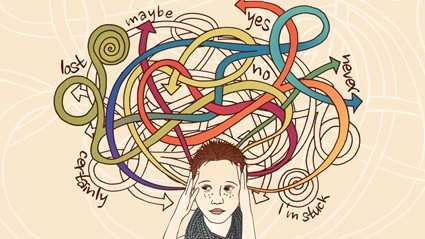Hello! My name is Meghan Sutter, and I am a Licensed Professional Clinical Counselor and Board Certified Behavior Analyst with Partners In Excellence across our metro locations. This year marks my 10th year in the ABA field with my passion for helping individuals with special learning styles and needs beginning early on in my life. I first heard of autism from my sibling’s primary care doctor, who worried that was the root of the developmental and behavioral concerns we were seeing as a family. We were handed pamphlets about autism and referred to one of the only locations skilled to provide an assessment at that time, with limited resources thereafter for help.
Years later, I remember trying to do my own research and wondering, is this really it? What do families really do when they need help? I remember coming across this acronym.. ABA… and having no idea what it was or if it actually “worked”. In that time frame to now, there have been exponential advancements in the research of highly effective and successful strategies to help develop skills that are harder to innately learn for some individuals with autism or other special needs.
As many of us have heard that saying, “If you’ve met one individual with autism, you’ve met one individual with autism,” it rings loud and true that there is not and never will be a one-size-fits all teaching technique or plan. Each individual has their own unique skill set and their own areas to grow. Some individuals may have additional layers of needs, whether it is shown through not having the ability to vocally communicate, expressions of behavior that may show in the form of worry or avoidance, or difficulties in becoming distracted or lacking focus. For the later layer I mention here, difficulties in becoming distracted or lacking focus, this is an area that may be seen more often than not.
When I reference distraction and having a hard time focusing, I am referring to attention-related difficulties. These difficulties can come across in many different forms and can be a formal comorbid diagnosis for many individuals with autism. Let’s look into these areas further.
What do attention-related difficulties look like?
- Not paying attention to the task/activity/person in front of you.
- Lacking sustained focus on the task/activity/person before you.
- Becoming easily distracted with other things going on around you.
- Having a hard time finishing a task or activity.
- Needing repeated instructions to complete a multi-step activity due to poor short-term memory for what you were supposed to do next.
- Poor listening skills.
- The above items may be paired with having a hard time sitting or waiting for a longer period of time.
- The above items may also be paired with engaging in behaviors that may be disruptive to others.

What is the comorbidity for individuals with autism?
- According to the Diagnostic and Statistical Manual – Fifth Edition, it reports that irregularities of attention are common in individuals with autism. It additionally goes on to note that about 70% of individuals with autism may have one comorbid disorder.
- More specifically, a recent 2019 study from the journal, Research in Autism Spectrum Disorders, examined 419 young people with a diagnosis of autism for comorbid attention-related diagnoses. The study resulted in 61% of those individuals as meeting a formal diagnosis for an attention-related concern.
- One big takeaway from this is that if you are experiencing working with or being a caregiver to an individual who is showing attention-related concerns, you are not alone! This may be their “layer” or one of their “layers” that requires additional individualization to identify the technique or plan that works best for them.

Now that we have an idea of what these areas may look like and how prevalent it may be, what can we do about it? Is ABA an effective treatment strategy for attention-related difficulties? Or do you need to look elsewhere? Let’s dive in.
Can ABA be effective as both an autism and attention-related problem strategy?
- You have come all this way and if by now, you are guessing “yes”, you are right, ABA can be an effective tool for helping attention issues!
- ABA at its core is meant for the modification of outward forms of behavior. That means that if there are behaviors that we would like to see grow or behaviors that we would not like to see happen anymore, different teaching techniques are able to be used to modify the likelihood that we see those specific behaviors happening again.
- Trial and error, as well as continued evaluation/adjustments, may be needed to “get it right”.
- Working with your team of professionals is best to identify any additional supports that may be needed.
What steps should you take to develop a strategy or plan to address attention-related difficulties?
- Identify the behaviors for change. Identify what behaviors you would like to see increase or decrease. Without this identification, there is no direction for behavior adjustment.
- Specify those behaviors for change. Get specific about what those behaviors look like that you want to modify or what you would want them to look like instead. As an example, one of the listed attention-related difficulties above of, “Lacking sustained focus on the task/activity/person before you,” may be specified further to include:
- What you want to see less of: Decrease of turning away from or wandering away from the task and decrease of continued engagement in own preferred activities despite instruction provided.
or
- What you want to see more of: Increase of active sustained attention that includes body oriented to the task and engagement in activity-related actions until the activity is completed.
- Identify the current skill level for the behavior(s) identified for change. In order to know where to start, you must first identify what the current skill ability is for the identified behavior of change in particular. There is another idiom out there, and maybe one of you will know it better than I, where you must learn to walk before you can run or learn to swim before you can dive. The concept is similar here, where for the highest level of success, work to develop skills that the individual is showing emerging abilities in before jumping to something more advanced or that the individual may not yet be ready for at that point. As an example, one of the listed attention-related difficulties above of, “Lacking sustained focus on the task/activity/person before you,” may include identification of:
- Current skill level: Individual shows ability to sustain focus across 2 different highly preferred activities for 5 minutes each.
- Identify building block steps to reach the behavior goal. In step 2, you are identifying the specific behavior for change, ideally your end behavior goal! With step 3, you are identifying where to start, so then what about the in-between? Here is where it really counts in breaking down steps that make it attainable for that individual to go from start to end. Some determining factors may include how fast of a learner the individual may be, the types of tasks that are associated with the goal, and motivation associated with the scenario. In keeping with our same example above of “Lacking sustained focus on the task/activity/person before you,” building block steps from current skill level to end goal may include:
- Expanding ability to sustain focus across a greater variety of highly preferred activities.
- Expanding ability to sustain focus across a greater duration with highly preferred activities.
- Using sustained focus ability with highly preferred activities to then build sustained focus with lesser preferred activities across amount of activities/duration of engagement.
- Using sustained focus ability with lesser preferred activities to then build sustained focus with non-preferred activities across amount of activities/duration of engagement.
- Important: Identify a motivator. One of the most impactful areas for modifying behavior is identifying a motivator for behavior change. The same is true when we are looking at adjustment of attention-related difficulties. Work to sample and identify an item/person/activity that not only provides enjoyment for the individual to engage with, but that shows promise in having high enough value to change the route of that behavior.

- Ensure consistency. Consistency is crucial for a strategy or plan to be effective. This may include evaluating what expectations should look like across people/caregivers, environments, and different scenarios. If there are inconsistencies or unclear expectations, there may be confusion or frustration from the individual, lack of sustained behavior adjustment in the direction you want it to, and potential need for shifting back a few steps in order to regain momentum.
- Use a team mentality. There are many people invested in your child’s life; No one is on an island. Reach out to the individual’s team of professionals – parents included! – to bring up areas for further growth, to problem solve, and to create a plan that feels attainable together.

References
American Psychiatric Association. (2013). Diagnostic and statistical manual of mental disorders (5th ed.).
Rau, S., Skapek, M. F., Tiplady, K., Seese, S., Burns, A., Armour, A. C., & Kenworthy, L. (2019). Identifying comorbid ADHD in autism: Attending to the inattentive presentation. Research in Autism Spectrum Disorders. https://www.sciencedirect.com/science/article/abs/pii/S1750946719301564.


Recent Comments